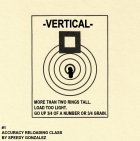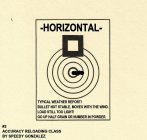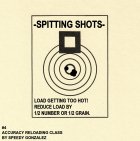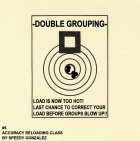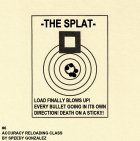I agree with Joshb. I think we who have tested enough loads all agree that there are "sweet spots" for certain powder charges - call them "nodes" or whatever. To me, a "node" is a series of charges that, from beginning to end, provide a nice group. Sometimes that "node" can be very narrow (such as getting good, then falling apart all within a grain, and sometimes very wide, where one has maybe a two grain or more sweet spot. The only way to find them is doing what you are doing - working the ladder. I typically start just above minimum charge and work up until I see signs of pressure, wherever that may be. Sometimes it is well below published max - and sometimes a bit higher. If the sweet spot is right at signs of pressure, I won't use that load, and if it was the only "acceptable" sweet spot found with that powder, I immediately move to another powder (or bullet). Contrary to some other postings here, I do find differences in seating depth. Just a few weeks ago for example, while working up a load for a new .22 Nosler barrel, I found the powder that was shooting the best overall groups, then ran the same load at four wide (.010") seating depths, starting with jam, then backing off in .010" increments to see the effect for further possible fine tuning. The seating depth changes not only dramatically affected my group sizes, but my SD's and velocities as well. Lots of little cogs in the wheel. I haven't watched the Hornady videos, so I don't know in what context they are using "nodes". Shooting the ladders is a time proven approach. Don't be concerned with such things as "flat spots" and such. Trust your target.I completely disagree with the idea that there aren’t nodes! Your method is exactly what I’ve been using for years and ALL of my rifles/barrels have nodes. Too many people want to be Utube celebrities and buck conventional wisdom to get attention. Ignore them! Listen to Eric!
You are using an out of date browser. It may not display this or other websites correctly.
You should upgrade or use an alternative browser.
You should upgrade or use an alternative browser.
Lost and Confused regarding Load Development
- Thread starter fattybinz
- Start date
Consistant velocity is not important under 300 yards. Short range records have been set with big ES.The big take away is "consistent" velocity.
Only change one thing at a time.
If it gets smaller, keep going in that direction.
If it gets bigger, then stop, or go other direction.
IF NOTHING MAKES SENSE, RE-TORQUE EVERYTHING. AND THEN CHANGE POWDER OR BULLET.
I have one bullet that people love and I've tried in 5 rifles and cannot get it even close to other what other bullets shoot.
pressure test first.... then you know safe range (10 shots about)
Seating depth in an area where they seemed to impact similar on pressure test. 5 groups of 3. Follow berger seating depth guidelines. (15 shots).
Then powder charge go up or down by 0.02.... if they get smaller keep going until they get bigger or you reach pressure. (15-20 shots)
At this point you should be about 40-50 shots and have a really good idea of the what the rifle can do.
If it isn't shooting great then change powder or bullet and repeat.
I’d say that it’s too close but I also don’t know if you’re neck is tight in the chamber, if the bullet is tight in the brass or if you’re brass is completely clean of lube. How many firings are on the brass and what brand? What reamer was used?I've had a few members above recommending working off of 31.5 gr. Is that far enough in your opinion from those pressure signs at 32.2?
nwmnbowhunter
Silver $$ Contributor
YesI've had a few members above recommending working off of 31.5 gr. Is that far enough in your opinion from those pressure signs at 32.2?
nwmnbowhunter
Silver $$ Contributor
AgreedConsistant velocity is not important under 300 yards. Short range records have been set with big ES.
X1 fired. Alpha. No idea what reamer was used. I'd have to ask the gunsmith that made it.I’d say that it’s too close but I also don’t know if you’re neck is tight in the chamber, if the bullet is tight in the brass or if you’re brass is completely clean of lube. How many firings are on the brass and what brand? What reamer was used?
Not being an expert about anything except ground hog behaviorI completely disagree with the idea that there aren’t nodes! Your method is exactly what I’ve been using for years and ALL of my rifles/barrels have nodes. Too many people want to be Utube celebrities and buck conventional wisdom to get attention. Ignore them! Listen to Eric!
When I started reloading and precision shooting eons ago, while we didn't call them "nodes" nevertheless the entire idea of load development was understood to find the "sweet spot" (node) that produced the best accuracy. I thought this was established engineering doctrine.
jelenko
Gold $$ Contributor
Maybe the confusion on whether there are nodes or not comes from some people using 'node' to mean a velocity node and others to mean an accuracy node.
Some people think there are velocity nodes; most people think [I would say 'know'] there are no velocity nodes.
Everyone agrees there are accuracy nodes. Some people think the accuracy node is also a velocity node.
As mentioned above, there physically cannot be velocity nodes.
Because the speed of sound in steel is about 10,000 fps, there MUST be some movement at the muzzle before the bullet reaches it. In fact, the sound wave from the powder burning rapidly travels back and forth from the breech to the muzzle more than once before the bullet gets there.
Some people think there are velocity nodes; most people think [I would say 'know'] there are no velocity nodes.
Everyone agrees there are accuracy nodes. Some people think the accuracy node is also a velocity node.
As mentioned above, there physically cannot be velocity nodes.
Because the speed of sound in steel is about 10,000 fps, there MUST be some movement at the muzzle before the bullet reaches it. In fact, the sound wave from the powder burning rapidly travels back and forth from the breech to the muzzle more than once before the bullet gets there.
speedygonzalez
Gold $$ Contributor
These may help! They are a visual representation of what my good friend Jack Neary spells out on his tuning for benchrest video and on one of my other bother's podcast Erik Cortina & Jack Neary.
Target #3 is an example of two group shapes, to the left a small triangular shaped group, at 5:30 on the bull is a small group we call "A DOT".
Keep'em Small,
Speedy
Links below;
Target #3 is an example of two group shapes, to the left a small triangular shaped group, at 5:30 on the bull is a small group we call "A DOT".
Keep'em Small,
Speedy
Links below;
Attachments
Keep listening to the guys that actually win competitions, (like Erik) I don’t think Hornady is wrong but I believe they are talking more to the guys that shoot factory hunting rigs and shot 1 group at .25 moa once and think they have a quarter minute gun. Follow Erik’s advise and I’m sure you’ll be fine.I follow Erik religiously. That is part of why I'm confused...he talks about finding the nodes, but then others dismiss those velocity nodes as a myth
Ruger15151
F-Class Shooter (6BRA and WIN 284)
You will always find 100 opinion on any forum. You have to follow those that have proven results. Erik is one of those that has success world wide. Also understand, benchrest methods don't always translate to disciplines where you have to load ammunition in advance. For example, in F-class, where we may need to load 300+ rounds in advance, we need to find a load that will have stable ignition in conditions that may be different than when we did load development. That is the point of trying to find noads where the velocities are fairly flat. In benchrest, they have the advantage of loading at the match so they don't really care about velocity, SD, or ES. They are just looking at the size of the small hole.I follow Erik religiously. That is part of why I'm confused...he talks about finding the nodes, but then others dismiss those velocity nodes as a myth
My advice would be to follow the loading techniques that most closely apply to the discipline you are shooting.
jelenko
Gold $$ Contributor
This^^^Don't be concerned with such things as "flat spots" and such. Trust your target.
CharlieNC
Gold $$ Contributor
A node as defined by Eric and many others is where the point of impact on the target is stable across several charge weights. While it may sound the same as the so called velocity node, it is not. This results from positive compensation due to harmonics. This only takes a couple of shots per charge to obtain a clear definition, and the group sizes will follow. Google Opimal Charge Weight or Audette Charge Weight Ladder.
Do you target shooters prefer the top or bottom of the "node".
As a hand loading hunter, I chose the top (fastest). And that was rarely book max.
This post taught me a different name for something I realized.
As a hand loading hunter, I chose the top (fastest). And that was rarely book max.
This post taught me a different name for something I realized.
You will get varied opinion on that, for sure. While I can only speak for myself, as one who almost always pre-loaded my ammo at home before going to a club match, it depended on the weather report. Knowing what was (somewhat) to be expected of my load in approximate different temperatures, I'd load up or down depending on what I though was needed to keep me in the middle of my sweet spot.Do you target shooters prefer the top or bottom of the "node".
As a hand loading hunter, I chose the top (fastest). And that was rarely book max.
This post taught me a different name for something I realized.
jelenko
Gold $$ Contributor
I look for the node with the most accuracy that is in or above the middle of the powder charge range.Do you target shooters prefer the top or bottom of the "node".
As a hand loading hunter, I chose the top (fastest). And that was rarely book max.
This post taught me a different name for something I realized.
Accuracy is #1 but shooting at 200/300/600 yards I also don't want my bullet dawdling.
For hunting, I would imagine you'd want the highest safe node for downrange impact. The difference between the node is no more than 1/2 MOA.
Similar threads
- Replies
- 22
- Views
- 716
- Replies
- 21
- Views
- 3,284
Upgrades & Donations
This Forum's expenses are primarily paid by member contributions. You can upgrade your Forum membership in seconds. Gold and Silver members get unlimited FREE classifieds for one year. Gold members can upload custom avatars.

Click Upgrade Membership Button ABOVE to get Gold or Silver Status.
You can also donate any amount, large or small, with the button below. Include your Forum Name in the PayPal Notes field.
To DONATE by CHECK, or make a recurring donation, CLICK HERE to learn how.

Click Upgrade Membership Button ABOVE to get Gold or Silver Status.
You can also donate any amount, large or small, with the button below. Include your Forum Name in the PayPal Notes field.
To DONATE by CHECK, or make a recurring donation, CLICK HERE to learn how.










